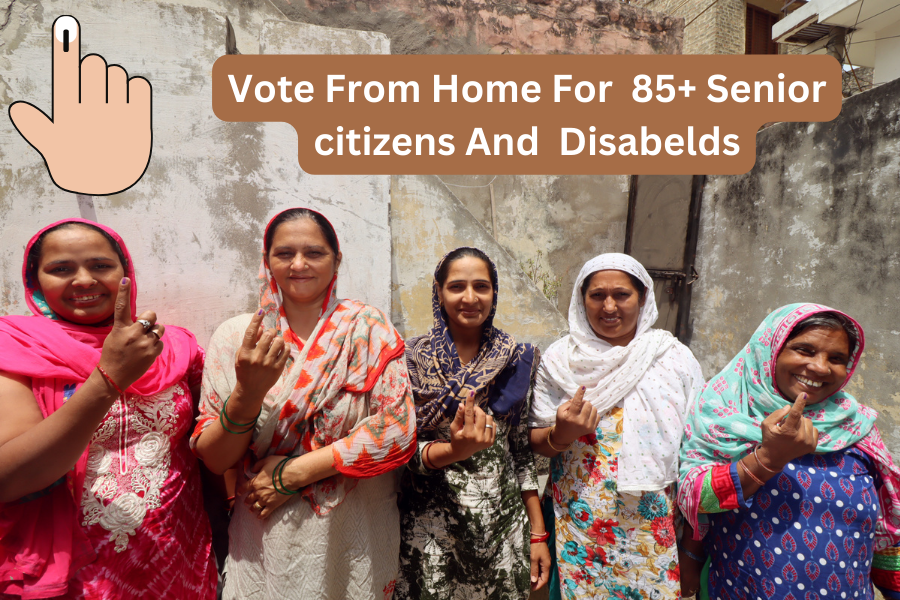The “Vote From Home” Option for Senior Citizens and Persons with Disabilities in India’s 2024 General Elections
Posted on : April 6, 2024 By Santo

Introduction
In a significant and historic move, the Indian Poll Panel has introduced the “vote from home” option for the first time in the upcoming 2024 general elections. This option is specifically extended to senior citizens aged 85 and above, as well as persons with disabilities (PWD). The voting process will take place across India’s 543 Lok Sabha constituencies in seven phases, starting from April 19 and concluding on June 1. The vote counting is scheduled for June 4.
The decision to introduce the “vote from home” option comes as a result of the ongoing COVID-19 pandemic, which has posed significant challenges to the traditional voting process. With the aim of ensuring the safety and well-being of vulnerable sections of society, the Election Commission of India has taken this progressive step to facilitate their participation in the democratic process.
The “vote from home” option will enable eligible senior citizens and PWDs to exercise their right to vote without having to physically visit the polling stations. This will not only make the voting process more accessible but will also help in reducing the risk of exposure to the virus, as these individuals are often more susceptible to its effects.
To avail of this option, eligible voters will have to register themselves through a dedicated online portal provided by the Election Commission of India. The portal will require them to provide necessary details and submit relevant documents to prove their eligibility. Once the registration is complete, the Election Commission will dispatch a secure electronic ballot to the registered voters via email or postal service.
The electronic ballot will be designed to ensure the privacy and secrecy of the vote, with robust security measures in place to prevent any tampering or manipulation. Voters will be able to mark their choices electronically and securely submit their ballots back to the Election Commission within a specified timeframe.
To further enhance the transparency and credibility of the “vote from home” option, the Election Commission will establish a dedicated team of officials to oversee the entire process. This team will be responsible for verifying the eligibility of the registered voters, ensuring the integrity of the electronic ballot, and securely counting the votes received.
The introduction of the “vote from home” option is a significant step towards making the electoral process more inclusive and accessible for all citizens. It not only acknowledges the unique challenges faced by senior citizens and PWDs but also demonstrates the commitment of the Indian Poll Panel to uphold the principles of democracy even in the face of adversity.
With the implementation of this innovative voting method, India sets an example for other democracies around the world to explore ways to adapt and evolve their electoral processes to meet the changing needs of their citizens. The “vote from home” option not only ensures the participation of vulnerable sections of society but also strengthens the foundation of democracy by promoting inclusivity and safeguarding the rights of every individual to have their voice heard.
Table of Contents
Eligibility and Inclusion To Vote From Home
To be eligible for the “vote from home” option, individuals must fall into one of two categories: senior citizens aged 85 and above or persons with disabilities with a benchmark of at least 40%. This initiative aims to include over 85 lakh senior citizens and more than 88 lakh persons with disabilities in the electoral process. This expansion of the scheme, previously tested during state assembly elections, now extends to older citizens and includes an increased age limit from 80 to 85 years.
The decision to include senior citizens aged 85 and above in the “vote from home” option is a significant step towards promoting inclusivity and ensuring that every eligible citizen can exercise their right to vote. With the aging population increasing, it is crucial to provide accessible and convenient voting methods for senior citizens who may face challenges in physically visiting polling stations.
Furthermore, the inclusion of persons with disabilities with a benchmark of at least 40% is a commendable effort to empower this marginalized group and give them an equal opportunity to participate in the democratic process. By expanding the scheme to cover a larger number of persons with disabilities, the government is taking proactive measures to address the unique needs and challenges faced by this community.
The success of the “vote from home” option during state assembly elections has paved the way for its implementation on a larger scale. The positive feedback received from eligible individuals who were able to cast their votes from the comfort of their homes has highlighted the importance of such initiatives in promoting voter turnout and engagement.
It is worth noting that the decision to increase the age limit from 80 to 85 years for senior citizens reflects a recognition of the changing demographics and the need to adapt to the evolving needs of the population. As life expectancy continues to increase, it is essential to ensure that voting methods accommodate the older generation and provide them with the necessary support to exercise their democratic rights.
In conclusion, the expansion of the “vote from home” option to include senior citizens aged 85 and above and persons with disabilities with a benchmark of at least 40% is a significant step towards promoting inclusivity and accessibility in the electoral process. By extending this scheme to a larger number of eligible individuals, the government is actively working towards ensuring that every citizen has an equal opportunity to participate in shaping the future of their nation.
The visit by the polling officials is scheduled in a way that minimizes inconvenience for the voter. The voter can choose a convenient time slot from the options provided by the Election Commission. This flexibility ensures that individuals with different schedules and commitments can still exercise their right to vote without any difficulty.
On the day of the visit, the polling officials will arrive at the voter’s home and set up a temporary voting booth. This booth will be equipped with all the necessary voting materials, including ballot papers and secrecy screens. The videographer will record the entire voting process to ensure transparency and prevent any fraudulent activities.
Before the voting begins, the polling officials will verify the identity of the voter using the information provided during the registration process. This includes checking the voter’s identification documents and comparing them with the details provided in Form 12D. This step is crucial to maintain the integrity of the voting process and prevent any unauthorized voting.
Once the voter’s identity is confirmed, they will be given the ballot papers to cast their vote. The voter can take their time to carefully consider their choices and mark their preferences on the ballot papers. The secrecy screens provided in the voting booth ensure that the voter’s choices remain confidential.
After the voting is complete, the voter will seal their ballot papers in an envelope provided by the polling officials. This envelope will be securely sealed to maintain the secrecy of the vote. The voter will also have the opportunity to verify the contents of the envelope before it is sealed to ensure that their vote has been accurately recorded.
Once the voting process is finished, the polling officials will collect the sealed envelopes and transport them to the designated counting centers. These centers are equipped with advanced technology and security measures to ensure the accuracy and confidentiality of the vote count.
Benifits Of Vote From Home
1. Cost Savings: Implementing the “vote from home” option can result in cost savings for the Election Commission. With fewer polling stations needed to accommodate voters, there will be a reduction in expenses related to setting up and maintaining these facilities. Additionally, the use of postal ballots can eliminate the need for transportation and logistics associated with traditional voting methods.
2. Environmental Impact: The “vote from home” initiative aligns with the global push for sustainability and reducing carbon footprints. By encouraging citizens to vote from their homes, it reduces the need for travel, thereby decreasing greenhouse gas emissions associated with commuting to polling stations. This contributes to a greener and more environmentally conscious electoral process.
3. Technology Adoption: The implementation of the “vote from home” option necessitates the use of technology, such as online registration systems and secure electronic voting methods. This encourages the adoption of digital tools and platforms, promoting technological advancements in the electoral process. It opens up opportunities for further innovation and modernization in future elections.
4. International Recognition: The introduction of the “vote from home” option showcases the country’s commitment to democratic values and inclusivity. This initiative aligns with international standards and best practices, earning recognition and appreciation from the global community. It highlights the country’s efforts to ensure equal participation and representation for all citizens.
Overall, the “vote from home” option provides a convenient and accessible way for eligible individuals to exercise their right to vote. The registration and voting process is designed to be user-friendly, transparent, and secure, ensuring that every vote is counted and every voice is heard. 6. Enhanced Efficiency: The introduction of the “vote from home” option streamlines the voting process and reduces the burden on polling stations. By allowing eligible individuals to vote from their homes, it decreases the number of people queuing up at polling stations, leading to shorter wait times and smoother operations on election day.
Share this articlePosted on : April 6, 2024 By Santo
Join Our Club

"Stay Informed, Stay Ahead – Join Our Club Today!"



















